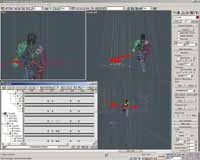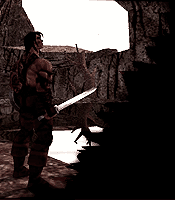|
3d Artist: Daniel Delgado
When I joined RAS I was finishing my university
degree in Technical and Artistic Architecture and I liked playing
with programs such as 3DS4. I also used to be not too bad in drawing
and knew one of the guys in Rebel who asked me if I wanted to try
to perform a trial to enter Rebel and I tried and I entered. That
was about 4 years ago, in October 1996.
 In
the screenshot I am working in one of the Kinematic scenes in the
game. We have been adapting all of them so that they look right
for every character in the game, giving each of them their own distinct
personality, and style of moving and behaving during these scenes.
This is one of the beginnings to a level. In
the screenshot I am working in one of the Kinematic scenes in the
game. We have been adapting all of them so that they look right
for every character in the game, giving each of them their own distinct
personality, and style of moving and behaving during these scenes.
This is one of the beginnings to a level.
Blue lines mark the trajectory of any of the
objects we want to have marked. In this case it is showing the motion
of the centre (main node) of the character. Each of the red boxes
means a point in which the centre has a position keyframe and is
exactly positioned in the point through which the centre has to
pass. We have developed a plug-in to convert the architecture of
the maps made by the level designers to a 3DS-Max mesh so that we
can create these scenes and make the characters respond to the real
architecture of the place in which the scene happens.
I have actually modelled three or four enemies
in the game. I have created the troll (design and model), the lich
(design and model), the "little thing" (that is totally
mine, I suggested to the MC actor how to move, and I cleaned the
animations for it. Only the design is by Jose Luis) and the golem
which is the first one I made and has some new skins made by Luismi.
The first one was the most difficult because
it was the first and all of the problems that can happen when modelling
happened on it and it was the first time I faced them. I have been
very miserly about polygons when modelling and I wanted that my
meshes have as few as possible so that the enemies that I created
could appear in groups of a higher number and be more fun, so that
was the challenge I imposed to myself.
Getting them to be functional was the greater
difficulty I found. The little thing for example has no more than
400 polygons and has its mouth articulated. The problems are very
similar for all of the meshes. Maybe the difficulty stands more
on the texturing than on the modelling. The troll may be the one
that made me work harder to get what you can see.
As for which ones I enjoyed working on the
most, I guess that's like asking 'Who do you love best, your mother
or father?!' Both, no other way to answer, though there are things
that sometimes make me wish I was working on the other thing. Modelling
usually is more interesting because it involves combining different
techniques (to work, that is). We draw with pencil first; we discuss
it with our artist boss; we model the mesh and then work with a
photo editor to make the texture. Then again turn to Max to apply
this texture. Its more diverse and changing from one thing to another
is nice. Animation on the hand is more difficult and requires more
attention that gives it an exciting taste, a higher challenge, but
its more repetitive and even routine sometimes. High polygon modelling
is great fun too, maybe the best, or not... well, I like 3D the
most.
The characters come about mostly by the combination
of one idea by Jose Luis and development by Luismi (some are exclusively
by Luismi). Some of them (the skeleton for example) were created
and developed by a modeller and designer who is not here and works
in Pyro Studios now. Some are mine in combination with that guy.
The "little thing" is, as I said, design of Jose Luis
and my development.
There are many techniques to model a character
and I am not a fanatic for any of them, I like to get from each
of the techniques the good things they have to solve the different
problems that can be found when modelling a low poly mesh. There
are parts of the body that get their shape from a primitive extruding,
moving vertices and tessellating faces until the shape shows; others
can be more easily done by having previous images of the front and
side of the object to model and creating vertices from zero and
then building the faces that they form.
This mixed technique has the problem of joining
the parts once done that have to be sawed carefully so that the
mesh looks right. Any modelling has to be started by having the
most exact possible image of the model we want. That means drawings,
notes, etc. not only for the general things but for all of the details
of the models, belts, scars, rags they may wear...
This is the normal sequence of events in
developing a model:
- Design drawings, sketches, all that may
be needed for a complete definition of it. Sometimes related and
based on the behaviour that is expected to develop that char.
- Mesh: work on Max 3 days modelling and
definition of stretchable faces and pivots for the animation.
- Texture: 1-2 weeks creation and applying
of it. We have developed little tricks for developing skins using
the tools in Max and Photoshop so that some of the actions that
at first we had to do manually and without precision can be precise
and mechanized so that the work is finer and more easy. We could
write a book telling the different and implausible tricks we have
tried.
The multiplayer game will consist of different skins for the main
characters but there is the possibility of adding enemies to the
list later once the game is out. Anyway I can assure you will
like the skins and they will be very different.
- Definition of helpers and dummies so that
the character has the capacity to inflict damage with his hands
and feet, how to grab his weapons, where to gather them at the
back, point of view, collision model etc. Time varies.
- Motion Capture: made with an optical system
has been carried out during three or four visits of 1 or 2 weeks
to the studio for all of the characters.
- Adapting the MC files created from a human
to the human (but different from the actor) meshes we have (not
too difficult) and to the non human ones... (you can guess not
so easy). We have our own MC importer and the meshes stretch in
a different way than Character Studio.
- Creating a database of information for the
biped system so that the engine knows for each of the 1500 animations
we have when the character is leaning its weight on one foot or
the other, when it releases the weight, when it starts an attack,
so that damage is activated only during the attacks, when to release
an object that is being thrown away or dropped and many many others.
This means we have to write lots of lines of never-ending script
files. You can see this is not our favourite job.
One of the versions of the amazon had a moving
pig-tail but changes had to be done, the design of the amazon changed
and we had to keep a coherence of pivots skeleton for the four playing
characters with the same number and structure of pieces. The one
you can see now (in the video) has a "compact" hair and
if it moves its because one of its "edges" is (let's say)
linked to the body, and the other to the head so the faces in between
get stretched whenever the head moves relatively to the body.
That is the same thing that happens to the
knight's tunic in the early scene in the video; one "edge"
related to the waist and the other divided into both legs so the
faces follow the relative movement dragged by their "edges".
It is a little more complicated but the essence is that. The meshes
have over 1000 polys but not many more. That is a game sequence
and uses the standard Knight.
I was asked if when you are in the middle of
combat and perform a combo and get hit by an enemy, does the animation
sequence (playing out the combo) stop. Yes, that is the way it works,
and personally I hate it when going to get a MegaCombo I get hit
and lose it. I prefer when I do it myself to an enemy or other player!
When you advance a level and get a new combo
it appears noted in the Travel Book, so I recommend taking a look
at it from time to time. It tells you how to make the combo. You
have to try it to get it.
At the moment here what we do is "what
is needed to the game". Generally I work on animations, but
they have just finished and now we have to touch up little things
that may look weird sometimes, look for small mistakes in the database,
make any test that is needed by programmers to work right etc. As
a background work we are creating the intro and outro and making
renders of the characters for the magazines and marketing.
Index
| Next
|





